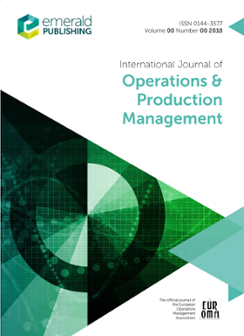利用社交媒体和大数据分析改进海上事故应急响应行动:若尾号海难案例研究
IF 7.4
2区 管理学
Q1 MANAGEMENT
International Journal of Operations & Production Management
Pub Date : 2021-09-17
DOI:10.1108/ijopm-12-2020-0900
引用次数: 6
摘要
目的本文旨在探讨大数据分析(BDA)新兴技术如何与社交媒体(SM)交叉。Twitter可以用来改善海事事故发生前和发生期间的决策。我们提出了一个概念性的早期预警系统,称为社区警报和通信系统(ComACom),以防止未来发生事故。设计/方法/方法基于二次数据,作者对MV Wakashio海上灾难进行了叙述性案例研究。作者通过使用媒体丰富性和同步性理论,采用了后建构主义方法,强调了来自社交媒体(SM),特别是推特的更广泛的社区声音。作者将BDA技术应用于实时推特数据集,以评估对海上紧急情况的行动响应。发现作者重新构建了四个不断升级的子事件的叙事,并说明了在组织和制度真空中做出的关键决策是如何导致灾难性后果的。我们强调了三个主要利益相关者(船舶组织、官方机构和更广泛的社区)的具体作用。我们的研究表明,嵌入我们的ComACom模型中的BDA增强的SM可以更好地实现对紧急事故的集体感知。研究局限性/含义本研究仅限于Twitter数据和一个案例。我们的概念模型需要付诸实施。实际意义ComACom将改进决策,最大限度地减少海事事故中的人为失误。社会影响将通过吸收更广泛社区的声音来改善应急响应。独创性/价值ComACom利用新兴的BDA/AI技术概念化了一个预警系统,以提高海上运输的安全性。本文章由计算机程序翻译,如有差异,请以英文原文为准。
Improving emergency response operations in maritime accidents using social media with big data analytics: a case study of the MV Wakashio disaster
PurposeThis paper aims to explore how big data analytics (BDA) emerging technologies crossed with social media (SM). Twitter can be used to improve decision-making before and during maritime accidents. We propose a conceptual early warning system called community alert and communications system (ComACom) to prevent future accidents.Design/methodology/approachBased on secondary data, the authors developed a narrative case study of the MV Wakashio maritime disaster. The authors adopted a post-constructionist approach through the use of media richness and synchronicity theory, highlighting wider community voices drawn from social media (SM), particularly Twitter. The authors applied BDA techniques to a dataset of real-time tweets to evaluate the unfolding operational response to the maritime emergency.FindingsThe authors reconstituted a narrative of four escalating sub-events and illustrated how critical decisions taken in an organisational and institutional vacuum led to catastrophic consequences. We highlighted the specific roles of three main stakeholders (the ship's organisation, official institutions and the wider community). Our study shows that SM enhanced with BDA, embedded within our ComACom model, can better achieve collective sense-making of emergency accidents.Research limitations/implicationsThis study is limited to Twitter data and one case. Our conceptual model needs to be operationalised.Practical implicationsComACom will improve decision-making to minimise human errors in maritime accidents.Social implicationsEmergency response will be improved by including the voices of the wider community.Originality/valueComACom conceptualises an early warning system using emerging BDA/AI technologies to improve safety in maritime transportation.
求助全文
通过发布文献求助,成功后即可免费获取论文全文。
去求助
来源期刊
CiteScore
13.30
自引率
17.20%
发文量
96
期刊介绍:
The mission of the International Journal of Operations & Production Management (IJOPM) is to publish cutting-edge, innovative research with the potential to significantly advance the field of Operations and Supply Chain Management, both in theory and practice. Drawing on experiences from manufacturing and service sectors, in both private and public contexts, the journal has earned widespread respect in this complex and increasingly vital area of business management.
Methodologically, IJOPM encompasses a broad spectrum of empirically-based inquiry using suitable research frameworks, as long as they offer generic insights of substantial value to operations and supply chain management. While the journal does not categorically exclude specific empirical methodologies, it does not accept purely mathematical modeling pieces. Regardless of the chosen mode of inquiry or methods employed, the key criteria are appropriateness of methodology, clarity in the study's execution, and rigor in the application of methods. It's important to note that any contribution should explicitly contribute to theory. The journal actively encourages the use of mixed methods where appropriate and valuable for generating research insights.

 求助内容:
求助内容: 应助结果提醒方式:
应助结果提醒方式:


